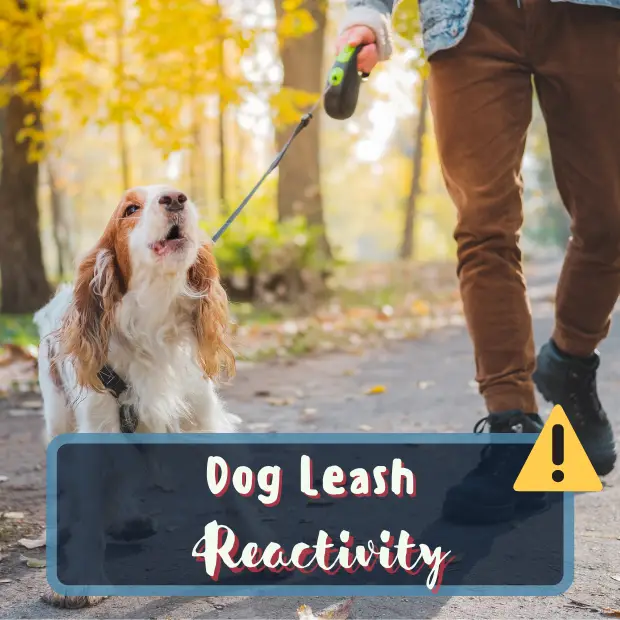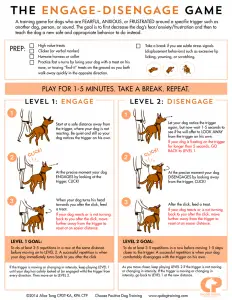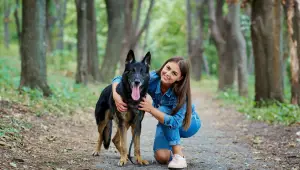If you’re interested in dog leash reactivity training, we’ve got all the answers to your questions.
Dog leash reactivity: What it is, how it happens and what to do about it.
Table of Contents
ToggleContents of this article:
- What is dog leash reactivity?
- What causes dog leash reactivity to start?
- What are symptoms of leash reactivity?
- Do you have a leash reactive dog?
- How does dog leash reactivity happen?
- Finding the cause of dog leash reactivity.
- Managing dog leash reactivity.
- Trigger stacking.
- How to stop your dog’s leash reactivity.
- Using lifestyle changes to help manage leash reactivity.
- What to watch out for in your leash reactive dog.
- Steps to help your leash reactive dog.
- Summary.
What is dog leash reactivity?
Leash reactivity is when a dog becomes agitated, overexcited, or defensive when on a leash. This can lead to a number of unwanted behaviors, including lunging, barking and even biting.
When dogs are reactive on leash, it can be very frustrating for dog owners.
Not only is Fido struggling with anxiety or excitement, but the owner is often pulled around and feels out of control.
This type of behavior can also be dangerous, as it can put both the dog and other people in danger.
What causes dog leash reactivity to start?
There are a number of ways that this type of reactivity can develop.
In some cases, dogs may become fearful or excited when they see other dogs or people while on a leash.
This can be due to a number of factors, such as incorrect socialization or having a previous bad interaction.
In other cases, dogs may start to become reactive when they are pulled on the leash.
This can be due to a lack of exercise or frustration with being restrained.
Often, this type of reactivity is seen in puppies who are still learning how to walk on a leash.
What are symptoms of leash reactivity?
There are a variety of ways that leash reactivity symptoms can manifest.
Some dogs may bark, lunge or growl at every person or pooch they see, while others may only react in certain situations such as when meeting a new person or being around multiple or particular individual dogs.
Do you have a leash reactive dog?
If you answer yes to any of the following questions, your dog may have a leash reactivity issue:
- Does your dog bark, lunge or growl or display behaviors which we may describe as aggressive when encountering people or dogs?
- Do you have trouble taking your dog for a walk because he barks, lunges or growls at every person or dog you pass?
- Does your pooch bark, lunge or growl when you try to put on the leash or when you’re getting ready to go for a walk?
- Do you have to keep your furry friend on a tight leash or in a specific area when out for walks because he barks, lunges or growls at people or dogs?
If you answered yes to any of these questions, your dog may have a leash reactivity issue.
How does dog leash reactivity happen?
There is no one answer to this question, as there can be a variety of factors that contribute to leash reactivity.
Some of the most common causes include fear, excitement or feeling frustrated.
Often, a dog will show reactivity when they are not familiar with the person or dog they are seeing, or when they are feeling overly stimulated or anxious.
Finding the cause of dog leash reactivity.
Dogs can become reactive on lead due to several emotions such as excitement, feeling frustrated or being afraid.
If you want to cure your dog’s lead reactivity, it is important to first determine what is causing them to feel this way.
- Excitement: They may bark, lunge or growl when they are overly excited (such as when they see a person or dog they love).
- Frustration: They may bark, lunge or growl when they are frustrated (such as when they want to get to something or someone but are being held back).
- Fear: They may bark, lunge or growl at a person or dog they are afraid of. This could be due to a past experience. When a dog has been attacked by one of their own kind, even without suffering a physical injury, they may become fearful of similar looking dogs or even all dogs.
You may be surprised to learn that your dog’s reaction stems from being afraid, as they look pretty confident when they’re barking, snarling, spinning and lunging right?
Wrong.
The majority of reactivity is fear-based, rather than true aggression. They are doing their best to scare away the scary thing before it gets too close.
Many dogs will exhibit different signs of fearfulness depending on the situation.
Many people assume that a fearful dog may be more likely to cower or hide when they see a trigger, whereas the majority will bark and lunge when they are around something that they are afraid of.
Many dogs become more dog selective as they age, which can lead to leash reactivity. It is quite unusual for dogs over the age of two years to want to be friends with every pooch they meet.
Some dogs are genetically more prone to this type of behavior, because of their breeding and the way they’ve been raised.
Dogs that were incorrectly socialized as puppies are also more likely to overreact in certain situations, although this is more likely to be due to excitement or feeling frustrated.
Dogs that have had free access to unstructured play with other dogs will react because their expectation when they see another dog is to play with it.
In many situations, such as walking near a road, it is not appropriate for dogs to play and the dog becomes frustrated, displaying reactivity-type behaviors.
For this reason, I advise my clients not to let their puppies play with random dogs and to teach them instead to focus on their handler when other dogs are around.
Some dogs may become leash reactive if they are over-stimulated by their environment and can’t regulate their excitement or anxiety. This can spill over into frustration and reactive behaviors.
Determining the root cause of your dog’s leash reactivity is the key to managing the behavior. Once you know what is causing your dog’s reaction, you can start working on a plan to address it.
If Fido is reacting out of excitement, then you’ll need to find ways to redirect his energy into something positive. This may include playing fetch or tug-of-war.
If your dog is afraid of other dogs or people, then you’ll need to start by helping him become more comfortable around them.
This involves a program of desensitization and counter conditioning, where we start observing the trigger at a distance and gradually moving closer over time at a pace that the dog can cope with.
This can be done with the help of a qualified trainer or behaviorist.
In many cases, leash reactivity can be managed and even cured with the right training.
Managing dog leash reactivity.
Some tips for managing your leash reactive dog:
- If possible, avoid putting them in situations where they are likely to become reactive (such as busy areas with a lot of people or dogs).
- When meeting a new person or dog, make sure to take things slow and let your pooch approach them at his own pace.
- Avoid going into areas where there is only one exit, such as narrow alleyways, which may force you to pass by a trigger at a proximity your dog cannot cope with. If your dog feels trapped and triggers encroach on their buffer zone, they may become reactive.
- If your furry friend becomes overemotional, calmly remove him from the situation and try to relax him with some scatter feeding or another calming activity.
- Make sure that you are always in control. This means keeping your dog on a short leash but aim to keep it loose. When there’s tension on the leash, the dog can feel trapped and is more likely to escalate their behavior, so avoid a tense leash if you can.
- If your dog is reacting to something he’s afraid of (such as a person with a beard), try to desensitize him to the trigger. Do this by slowly introducing him to the person or object in a controlled setting (such as during a training session) and at a distance where your dog is under their threshold and happy to eat training treats or other food.
- If your dog is reacting out of excitement, try to redirect his energy into something positive such as playing fetch or tug.
- If your dog is reactive to the point of redirecting onto their handler, fitting a good quality basket muzzle may be required to keep everybody safe.
- Be patient and consistent with your training. It may take some time and effort, but with patience at every step you can help your dog overcome this issue.
If your dog has a behavior problem, it’s important to address it as soon as possible. This can be done with the help of a professional trainer or behaviorist.
Trigger stacking.
Trigger stacking can be a major contributor to dog leash reactivity.
This happens when a dog is exposed to too many triggers in a short period of time.
For example, if you’re walking your pooch and a person with a beard strolls by, and then a cyclist goes by, and then a truck drives by, your dog may become overwhelmed and start to react, even if they seemed to cope well with the first few triggers.
To help manage the problem, try to avoid exposing your dog to too many triggers at once.
If there are lots of people and dogs around, try to keep your dog on the other side of the street.
If there are lots of loud noises, try to stay away from busy streets.
How to stop your dog’s leash reactivity.
Stopping leash reactivity can be a difficult process, but it’s not impossible. With patience and the right training, you can help your dog overcome this behavior.
If your pooch is particularly reactive to one type of trigger, such as other dogs, you can try to avoid exposing them to that trigger as much as possible.
This may mean avoiding busy areas or times, or taking a different route when walking.
It can be helpful in reactivity cases to manage your dog’s general stress levels.
Using lifestyle changes to help manage leash reactivity.
One way to reduce stress is by making sure your furry friend has a predictable routine. This means sticking to the same walk times, feeding schedule etc.
Dogs that are unsure of what’s going to happen next can often become agitated and stressed, which can contribute towards leash reactivity.
Enrichment activities.
By ensuring they get plenty of opportunity to engage in activities such as sniffing, licking and chewing, you can help to keep their stress levels low and their mind occupied.
In most of my face-to-face cases, I advise pet parents to make use of the dog’s daily ration of food, as follows:
- 1/3 from a bowl
- 1/3 for training
- 1/3 for enrichment activities that involve sniffing, licking and chewing.
Sniffing, licking and chewing are all calming activities for dogs, as they release endorphins that help to reduce stress.
Dogs have an incredible sense of smell, and by allowing them to engage in activities that allow them to use their noses, we can help keep them calm and happy.
When a dog is stressed, they may lick or chew on objects as a way to self-soothe.
Allowing them to do this in a safe and controlled environment can help keep them from becoming reactive in other situations.
What to watch out for in your leash reactive dog.
Look out for early signals of tension in your dog’s body language when you are out on walks.
Keep an eye out for “out of context” behaviors such as lip licking, yawning, suddenly stopping to scratch or groom themselves.
If you see these behaviors start to occur, it’s a good indication that your dog is starting to become overwhelmed or stressed.
Steps to help your leash reactive dog.
- Practice the “engage/disengage” game with anything exciting or worrying. This is teaching your dog an alternative behavior as a response to seeing a trigger. We get the dog to notice the trigger at a distance, and at the precise moment they look at what worries them, use a marker and reward your dog with a dog treat. Start with easy triggers first, anything that grabs your dog’s attention, and build up to things that your dog finds more difficult to look away from. You may need an assistant with a helper dog for training sessions of this exercise.
- Teach your dog focus exercises such as the “1-2-3-catch” game and start to use it at random times during walks, so that they have a reason to engage with you instead of getting distracted and worried by their surroundings.
- Work on quick changes of direction at random times in your walking so that you can pivot your dog around to avoid a trigger if you need to. Make this exercise fun, and use a “this way” cue so that your dog doesn’t associate this with anything scary or worrying.
- Work on loose leash walking using the 300 peck method.
- Attach your dog’s leash to a harness rather than a collar. When a dog lunges towards a trigger they may make a negative association with feeling uncomfortable around their neck and try to warn the trigger away at a greater distance.
Summary.
Leash reactivity is a common problem, but it can be overcome with patience and the right training.
Lifestyle changes, enrichment activities, and focus exercises, along with desensitization and counter conditioning to triggers, are all essential components to help your dog stay calm.
Look out for early signs of tension in your dog, and use quick changes of direction to avoid triggers. Practice loose leash walking using the 300 peck method for best results.
Teaching your dog coping skills can lead to lasting behavior change.








